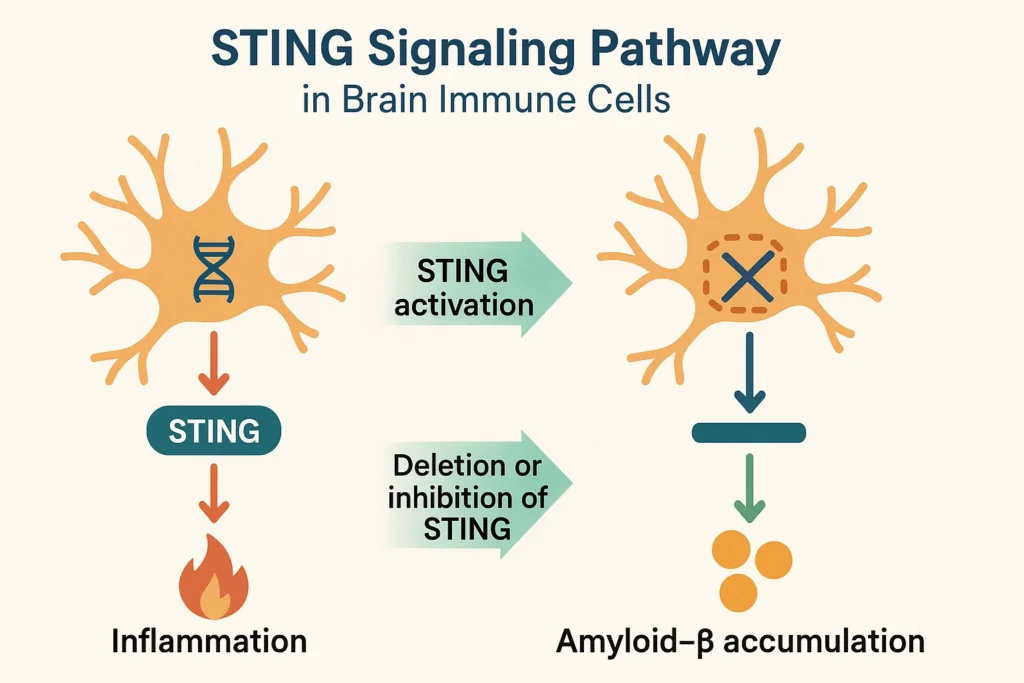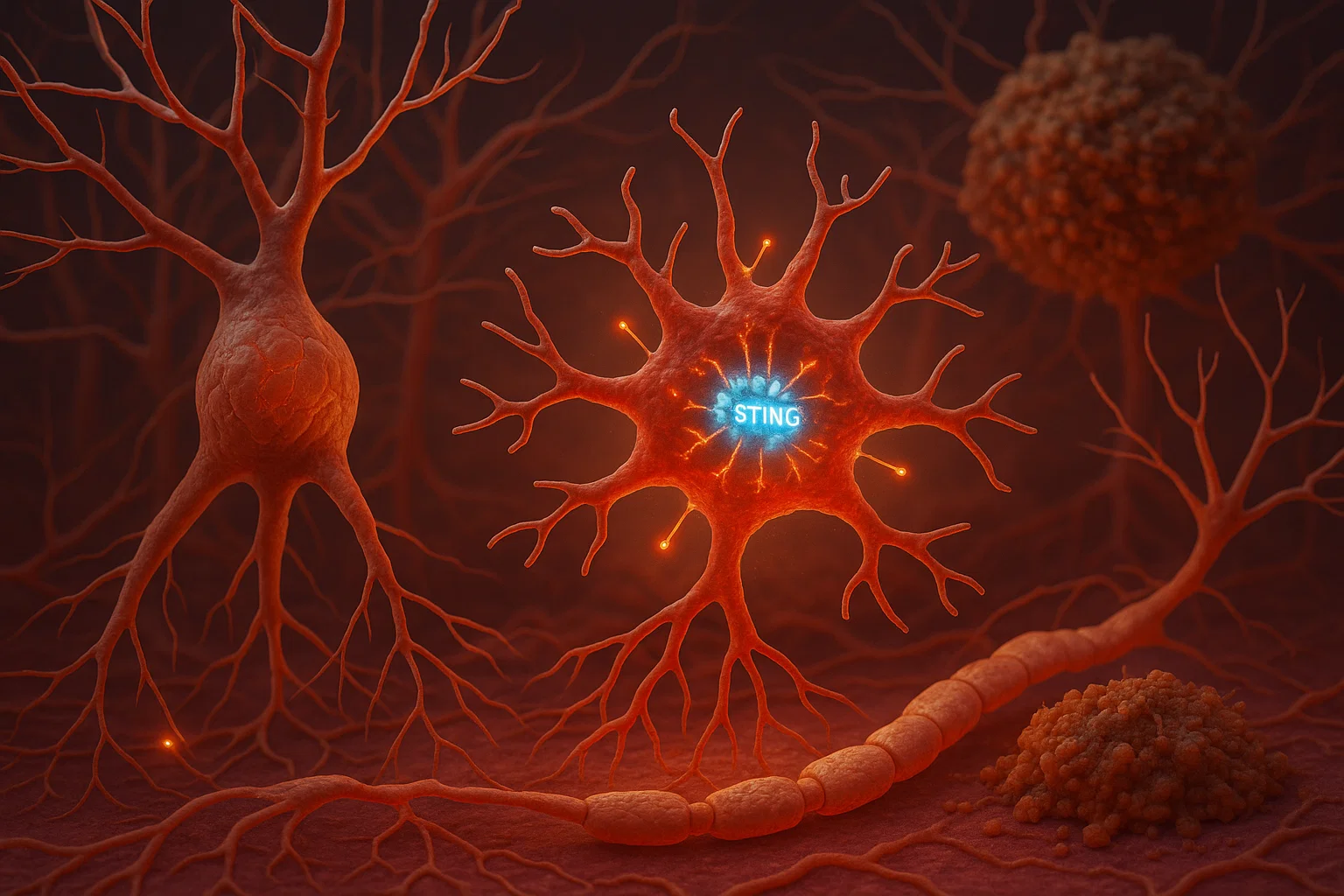Alzheimer disease (AD) is a crippling neurodegenerative condition, with a huge global prevalence of millions of people, which results in memory loss and cognitive decay, as well as, reduced ability to go out and perform everyday activities. The pathology of the disease is mainly described as the presence of amyloid beta (A2) plaques and tau tangles in the brain that damages. neurons and leads to their death.
Over the past few years, research has begun to discover more involvement of the immune system in Alzheimer developments, particularly by looking at the existence of immune cells within the brain (microglia) in the development of Alzheimer. Such immune cells usually serve to eliminate harmful substances but may become hyperactive and induce a state of chronic inflammation, which aggravates brain damage.
The current research study, conducted by the University of Virginia scientists, provides insight into one of the most fundamental molecules of the immune system, the STING molecule (Stimulator of Interferon Genes), and its relevance to AD development. Their results create a potential new treatment avenue.
So What and Why is STING Important to Alzheimer patients?
STING is a key protein component of innate immune response of the body. In the cells, it is a DNA damage sensor that causes inflammation to combat illness or harm. Whereas in normal circumstances this process is protective, chronic activation of STING has the potential to cause deleterious chronic inflammation.
During the process of Alzheimer, the activation of STING is overly expanded and enhances the neuroinflammation that aggravates the formation of the A beta plaque and tissue loss.
Key Findings: How STING Deletion Protects Against Alzheimer’s Pathology
They used a genetically altered mouse model; 5xFAD, representing biological analogue of human AD amyloidosis and investigated the changes after the STING gene had been removed. What they discovered is:
Less Amyloid Beta Plaques
The mice deficient in STING developed by far less and smaller amyloid beta plaques in important parts of the brain that are paramount in memory and learning like cortex and the hippocampus.
Microglial Activation can be altered.
The STING-deficient mice had microglia with less activation and less inflammatory nature, a more healthy and homeostatic condition. This hindered overinflammation that normally damages neurons.
Better Neuronal Health
This involves the reduction of less neuritic dystrophy or swelling and injury of the neurons projections and decreased oxidative stress destroying cells in the brain.
Prevention of Mental Degeneration
Behavioral tests showed that STING-deficient mice showed improvement with regard to memory and spatial learning in comparison to the typical AD model-network mice showing that the cognitive ability is maintained.
Why Are These Results a Game-Changer
This study highlights STING is among the key influencing factors in neurodegeneration in Alzheimer disease by promoting the amyloid build-up and neuroinflammation. Removal of STING through genetically crippled its function and the researchers ultimately achieved the result of slowing down the disease pace and safeguarding brain health.
This discovery is especially interesting since it has a targetable immune process. The STING-activated programs that are harmful show potential to inhibit the STING activity and thus lower pathological inflammation, potentially slowing or inhibiting the AD development in patients.
What is the Effect of STING on Advancement of Alzheimer Disease?
STING usually stimulates the production of inflammatory substances known as type I interferons, and cytokines, including interleukin-6 and tumor necrosis factor-alpha. In AD, there is an overshoot of this signaling resulting in:
Greater formation of amyloid plaque
Dysfunctional microglia and chronic inflammation
Neurotoxic oxidative stress Oxygen toxicity
Cognitive impairment
The new study demonstrates that in the absence of STING, these pathological events are reduced, which enables microglia to have a balanced reaction that promotes fixing in the brain and explains neuronal life.

Broader Implications for Neurodegenerative Diseases
In addition to Alzheimer, STING and cGAS upstream regulator are also related to other neurological diseases, including Parkinson disease, amyotrophic lateral sclerosis (ALS) and age related dementia. Inhibition of STING may thus have far-reaching therapeutic uses.
What’s Next? The Way to the New Treatments
Although this study involved genetic deletion of mice, the drug development of STING inhibitors is in progress. A few experimental drugs have already demonstrated activity in animal models of lowering inflammation and amyloid pathology.
The next studies in this area will concern:
The creation of safe and effective human-targeting, STING drugs
Determining the specific cell types, in which STING functions in AD
Scientists study STING inhibitors to test the efficacy and safety of the research on humans in clinical trials
Conclusion: A New Hope in the Fight Against Alzheimer’s
Alzheimer disease is one of the most significant conditions affecting people across the world and it is rarely treatable. This finding of the essential role of STING in the promotion of amyloid and neuroinflammation provides a potent new target of therapeutic interception.
Reducing pathological immune activation through future STING-directed efforts could become effective strategies to preserve brain health, enhance cognition, and eventually alter the outcomes of the Alzheimer disease.
Reference:
Thanos, J. M., et al. (2025). STING deletion protects against amyloid β–induced Alzheimer’s disease pathogenesis.

